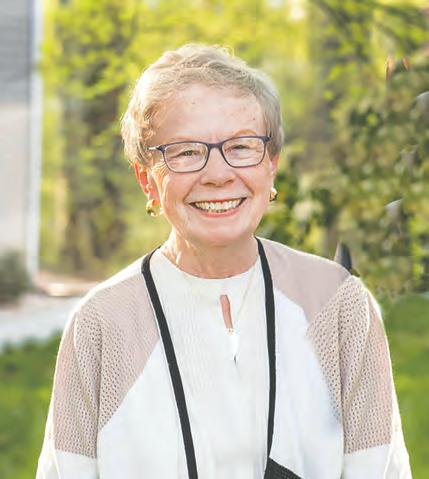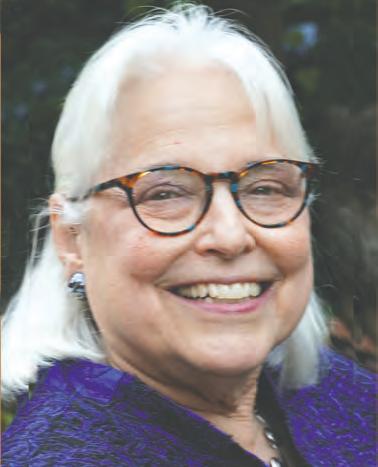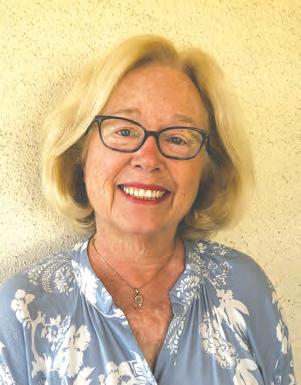
4 minute read
Telling Our Story, In Our Own Words
Overbeck Oral History Project Begins a New Chapter on Capitol Hill
by Barbara Wells
There’s an old saying in our neighborhood: You don’t move to Capitol Hill. You join Capitol Hill. But what does that really mean? How did this community come into being? Who were the people who shaped it — and who are we today?
For more than 20 years, the all-volunteer Ruth Ann Overbeck Capitol Hill History Project has brought the answers to light. Launched by the Capitol Hill Community Foundation in 2001, the project has created a treasure trove of 230 recorded interviews with residents who witnessed and contributed to our shared history.
Now, as project leader Bernadette McMahon passes the mike to Maygene Daniels, the project is poised to expand its mission and en- gage a new generation of Capitol Hill’s growing family. “We’re open! We’ll be calling for volunteers and ideas,” Daniels says. “We have a wonderful foundation and a great platform for sharing our community’s story for many years to come.”
Following the “Actuarial Imperative”
John Franzén led the Overbeck Project from the start, recording 24 hours of interviews with Overbeck herself, in the weeks before her untimely death, to preserve her vast knowledge of Capitol Hill dating back to the 1600s. Overbeck had completed voluminous research on the neighborhood, compiling oral histories, photographs, maps and other documentation for dozens of papers, presentations and articles.
McMahon soon joined Franzén, identifying subjects to interview and recruiting and training volunteers to record their memories — first on tape and later using digital equipment — to create a narrative blending many voices across all backgrounds and walks of life. She would eventually establish standard operating procedures and compile a database of almost 1,000 contacts.

Even as the Overbeck Project began recording residents’ stories, McMahon incorporated interviews dating back to 1974, which Overbeck and Hazel Kreinheder had conducted to document the neighborhood’s history for the application to establish the Capitol Hill Historic District. “Hazel still had some of the tapes and worked with Paula Causey for several years to transcribe and edit them,” McMahon recalls. “They produced 10 interviews for the project’s website, including a few with residents who were born in the 1800s.”
Nancy Metzger contributed additional interviews that she had conducted for the Restoration Society’s newsletter. “We followed Nancy’s actuarial imperative,” McMahon says. “Interview the oldest people first!” She remembers many of them as she would old friends — folks like:
• Jim Finley, who moved to the Hill as a teen in the 1940s and ran a boxing gym on the second floor of his auto repair shop on 10th St., NE, where everyone from street kids to lawyers and even Sugar Ray Leonard came to spar.
• Rosetta Hall Hamm, born on the Hill in the 1930s, who worshiped from the segregated seating in the rear of St. Peter’s Church on 2nd St., SE, and operated the elevators of a department store with dressing rooms for whites only.
• Sidney Hais, who was born in 1914 above his father’s market at 7th and C St., NE, and was at Griffith Stadium when the Washington Senators won the 1924 World Series in the 12th inning of game 7.
• Ben Williamowsky, who came to the Hill as a teen in 1939 when his father became Rabbi of the Southeast Hebrew Congregation on 9th St., SE, serving Capitol Hill’s the large Jewish community.
Harnessing Technology To Provide Access
One of the project’s greatest challenges has been figuring out how to make its rapidly growing library of re- cordings and transcripts easy to access. In 2018, the Capitol Hill Community Foundation funded an extensive e ort to modernize the website that showcases the collection.


“The website is the real key, because it’s expandable and searchable,” says Daniels, the retired chief archivist for the National Gallery of Art who ran an oral history project there. “Although the site allows you to skim through a gallery of interviews, people usually read oral histories with direction — and categories like topics and time frames can be subjective. This site is searchable by words, enabling users to nd stories of particular people, places, events and more.”
“One of the most fun things for me is when I run into something in a transcript and think, ‘I’ve heard that before,’” says McMahon. “Now I can do a search on the website and nd someone else who said the same thing — like, ‘Yeah, those two brothers were bullies!’”
Expanding the Mission
Three years ago, Elizabeth Lewis, who chairs the Overbeck Project’s interview committee, had just recruited a new group of volunteers when COVID-19 put the brakes on live interviews. That actually created an opportunity to use Zoom for remote interviews with people who had moved away from the Hill. “Randy Norton probably did all the interviews last year,” McMahon says with a chuckle, including one with Capitol Hill Arts Workshop founder Sally Crowell from her home in Connecticut.
Today, as Capitol Hill emerges from the pandemic, the project can explore new avenues for preserving our living history. “My role is to enable my talented neighbors to identify topics of interest and record stories about them,” Daniels says. “When the proj- ect started, we were focused on interviewing old timers — residents who were legends in their own time. Now we can build on the project’s extraordinary resources to protect, preserve, make available and expand on our stories.”
The challenge: How do you see what’s changing before your very eyes and capture the insights and re ections of the people experiencing life in the shadow of the Capitol today?
Daniels notes that residents have lived through major events like the January 6 insurrection, which led to the sudden installation of fencing around the Capitol grounds and the arrival of National Guard troops stationed at every corner. But they have also experienced changes over decades, like gentri cation, subway construction, the transformation of the Old Naval Hospital into Hill Center, and the evolution of neighborhood schools, churches, corner stores and other institutions. Even in the wake of minor events, like a Major League baseball player moving into a house on the Hill, all the neighbors have a story to tell.
“These changes have such an impact,” Daniels says. “They are at the heart of what Capitol Hill is as a community.”
Daniels envisions working with McMahon and Lewis to gather volunteers together to share their ideas, to brainstorm on subjects of interest, to collaborate on ways to gather stories and to learn how to conduct an interview. These volunteers will become ambassadors for expanding and promoting the Overbeck Project’s legacy.
“We’ve put in thousands of hours of work to create this rich resource,” McMahon says. “So we want to make sure that every resident and newcomer has heard of it.”











